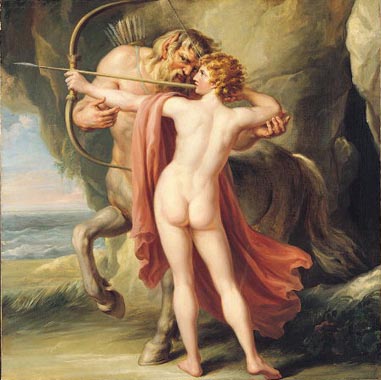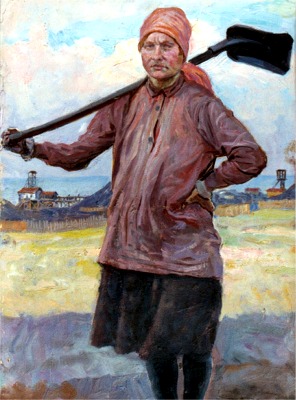
The History of the Peredvizhniki and the Formation of the Society for Traveling Art Exhibitions:
From the mid 18th century until the mid 19th century, art education in Russia was primarily dominated by the highly conservative Imperial Academy of Arts in St. Petersburg. Academic and Neo-Classical styles and techniques dominated the curriculum and professors emphasized the importance of Italian art, considering it to be the highest form of historical painting. Along with this emphasis of specific technique and style, strict subject matter of mythological, historical, biblical, and evangelical scenes were praised by the academy while other themes in the form genre painting were looked down upon. This was manifested in the annual Gold Metal Painting Competition held by the Academy in 1963. The proposed topic for the competition of which the artists were to depict was the mythological subject of "the Entrance of Odin into Valhalla." The following is an example of an Italian Neoclassical painting with a mythological theme.

"Chirone educa Achille al tiro con l'arco" (1776-1777).
Battista Cipriani
Neoclassicism
in Italy from Tiepolo to Canova
The constraints of this competition led to a demand by a group of thirteen contestants to change the competition guidelines. Instead of having an assigned topic, they wanted to paint whatever subject matter they chose individually. This led to a standoff between the Academy and students, resulting in the group of thirteen artists (I.N. Kramskoy, B.B. Venig, N.D. Dmitriev-Orenburgskii, A.D. Litovchenko, A.I. Korzhukhin, N.S. Shustov, A.I. Morozov, K.E. Makovskii, F.S. Zhuravlev, K.V. Lemokh, A. Grigor'ev, M. Peskov, and N.V. Petrov) all refusing to participate in the competition and resigning from the Academy all together. The theme of the competition would have limited their artistic expression. They felt that the subject matter of the competition was not important to paint because the Academic and Neoclassical Mythological painting theme had nothing to do with real Russian life and the problems that Russians throughout the country were facing. The artists wanted to focus on Russian issues and create their own Russian art that would enable them to educate the viewer about the hardships of the peasantry, the value of the peasantry, and the corruption of the dynastic rule and the system within which they all lived.
After they left the Academy, these thirteen artists, many of whom came from lower classes, formed an Artists' Cooperative Society which evolved into the Society for Traveling Art Exhibitions in 1870 of which the members came to be known as the Peredvizhniki. Many new members joined including Ilya Repin and Vasily Surikov and a similar style of realist painting that was easily interpretable and clear to the common man evolved.
Traditionally, significant art exhibitions of Academy painters were limited to the major cities of Moscow and St. Petersburg and were viewed mostly by the upper class elite. The majority of Russia was only able to view the works as small and poorly made reproductions in art journals or exhibition catalogues. Coming from humble beginnings, the Peredvizhniki formed this traveling society not only to paint subject matters that related to the issues of the common people of Russia like their families, but also to physically bring their artwork to the people of the whole of Russia. They exhibited their works throughout the provinces in many cities and towns, enabling their artwork to educate the masses. By 1897, the society had put on 25 exhibitions which had traveled across Russia to Kiev, Kharkov, Nizhnii Novgorod, Kazan', Samara, Penza, Tambov, Kozlov, Voronezh, Novocherkassk, Rostov, Taganrog, Ekaterinoslav, and Kursk. By combining the educational role of their work with the high accessibility of their exhibitions, the Peredvizhniki contributed to the Russian Cultural Revolution by providing the masses the knowledge, mind states, and value systems needed for revolution.
The Society for Traveling Art Exhibitions survived until 1923 when the Peredvizhniki joined the Association of Artists of Revolutionary Russia. The Peredvizhniki were admired later by Soviet authorities and were a great influence on the Socialist Realist movement. Their influence on the Socialist Realists can be understood in the ways Socialist Realism tried to re-educate the masses with a truthful concrete depiction of reality in its revolutionary development. Both movements wanted to use their works as educational tools to combat social and economic injustices. The following are examples of Socialist Realism. Similar to Repin's "Barge-Haulers on the Volga (The Volga Boatmen)" and Kramskoy's "Woodsman" these images celebrate members of the non-elite working class.

"Young
Steel Workers" (1961)
Ivan Bevzenko

"Female
Worker" (1929)
Boris Jeremejewitsch Wladimirskij (Boris Eremeevich Vladimirski)
Socialist Realism Links: